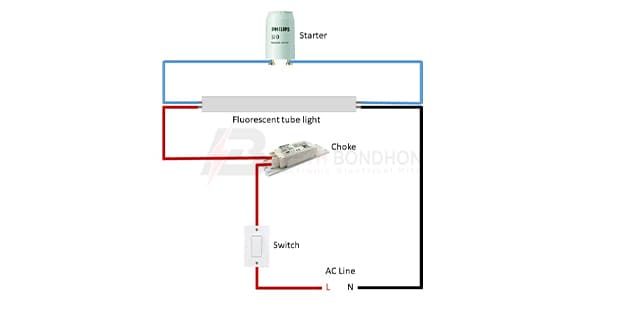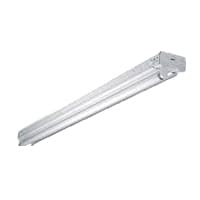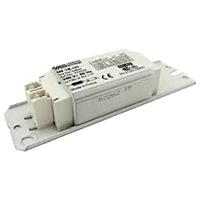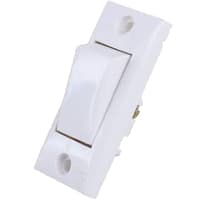Tube light connection:
This diagram shows how to make a tube light connection. In this circuit, we use a tube light starter, a fluorescent tube light, a ballast choke, and a switch. First, we need to connect the phase line to the switch and the neutral line to the fluorescent tube. Then input the phase line to the ballast choke, then connect the tube from the chock connection. And last we need to connect the tube light starter. Now this circuit is ready. If you want to know more about this circuit please check our youtube video below the post.
Advertisements
Components needed For this Project:
You can get the components from any of the sites below:
- Fluorescent Tube [See Buy Click Amazon]
- Electric ballast Choke [See Buy Click Amazon]
- SPST Switch [See Buy Click Amazon]
- Tube Starter [See Buy Click Amazon]
*Please note: These are affiliate links. I may make a commission if you buy the components through these links. I would appreciate your support in this way!
Advertisements
Components used to make the Tube light connection:
The structural element of the tube light is an airtight glass tube which is commonly called a sealed glass tube. This tube is airtight. The tube fills with a small amount of mercury. Also contains an inert gas (usually argon). The tube inside is also coated with phosphorus. That is why it looks white. There are 2 electrodes at both ends of the tube which can create an electric field between them. These 2 electrodes are again connected to an electrical circuit. Electrical This circuit usually consists of a starter switch and ballast. This circuit is connected to our AC supply. The difference between ordinary incandescent bulbs and fluorescent bulbs (which we call tube lights) is the process of activating or exciting the atoms. In normal bulbs, the atoms are activated by heating. In fluorescent bulbs. this is done through accelerated chemical reactions.
02. Ballast Choke:
After the starter, the important component responsible for lighting the tube light is the ballast. The primary role of the ballast in a tube light system is as a current regulator and illuminant. This ensures adequate voltage and waveform supply to the tube light. The type of ballast we used to see in old-fashioned tube light systems is actually an Electrical ballast that preheats the tube light. Ballast means balancing. Basically the tube light system also ballast plays the role of a balancer. It stabilizes the current and voltage. If a tube light is connected directly to the main line without this ballast, excessive current will flow through the tube light. As a result, the tube light will be destroyed almost immediately.
An SPST (Single Pole Single Throw) Switch is a Switch That only Has a Single Input and can Connect Only to one Output. This means it Only Has one Input Terminal and Only 1 Output Terminal. A Switch is a Mechanical or Controlling Device That Changes the Flow of Current Direction or Interrupts the Flow of Current Within a Circuit diagram. An electrical line using Single Pole Single Throws (SPST) is Perfect for on-off switching. When the SPST is closed, the Circuit is Closed and the light from the lamp switches on the system. When The Single Pole Single Throw (SPST) is then opened, the light from the lamp goes out and the Circuit is off.
04. Tube Starter:
The initial starting phase of the functioning of fluorescent tubes and lamps is aided by the employment of fluorescent starters or glow starters. Fluorescent starters are essentially timed switches. The switch is opened and shut repeatedly until the fluorescent tube "strikes," turning on. The Switch resumes its cycle of opening and closing, and if the fluorescent tube still does not light, it makes another effort.
Thank You for visiting the website. Keep visiting for more Updates.
Frequently asked questions
Fluorescent starters or glow starters are used to help fluorescent tubes and lamps ignite in the power supply initial starting stage of their operation. Simply put, fluorescent and starters are a timed switch. The switch opens and closes until the Project system fluorescent tube 'strikes' and lights up.
Most of what differentiates these tube types From each other depends on whether it uses a ballast or bypasses it, as well as whether it uses single or double-ended wiring. The power supply main types are Direct Wire (also known as ballast-bypass or Type-B), Electronic Ballast and Compatible, Hybrid, and Universal Ballast and Compatible.
The technical implications are therefore quite different. For this reason, LED tubes do not require any ballast or starter. These components are not located in the fluorescent and tube but in the socket. So if you want to convert the fluorescent tube to LED, you should also convert the power supply socket.
LED tube lighting is the power supply's better choice because it lasts about 40,000 hours longer in testing, is more energy efficient, will save you more money, and will leave less impact on the Circuit diagram environment. If you are interested in learning more about our LED offerings, please use our contact power supply form.
When compared to other types of lighting products, LED lights are the most energy efficient and offer a brighter light for the same wattage. Good and quality LED fixtures now output around 170 lumens per watt; as a fluorescent puts out around 110.
Read more Single Phase Wiring
What is a kilowatt-hour (kWh) | kwh formula | What does kwh mean
Introduction to Electrical Units and CircuitskW and kWh on your electricity bill As your home uses electricity during...
What is the Difference Between kVA | What does KVA mean | kVA formula
Difference Between KVA ExplainedWhat does KVA Mean? There are technical terms aplenty when it comes to generators, and...
Power Factor | Power Unit | Energy | Electricity Unit
Power factor definition | Calculating Power FactorPower Factor Values In a purely resistive circuit, the power factor...





0 Comments